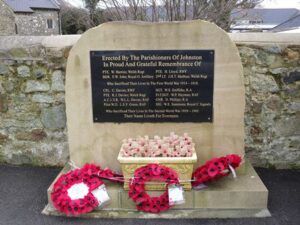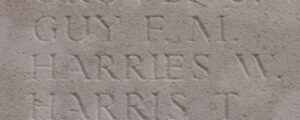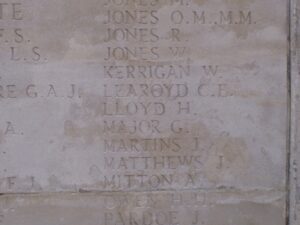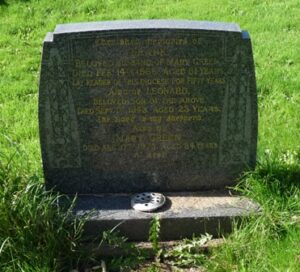Johnston is a large village, sited on the main road between Haverfordwest and Milford Haven. Originally, at the time of writing, the village did not have a WW1 War Memorial, only one for WW2, so I researched men from the village who had fallen in WW1 and added them below. Since then a new memorial has been dedicated which commemorates for men who fell during WW1 and eight who fell in WW2. Sadly six men of the area who fell during the First World War and two men from the Second World War have been omitted. I have made a note against the write-ups of the men below who are missing.

The Great War, 1914-1918
Frederick Bevans, Driver, 91785, Royal Field Artillery. Frederick was born on 16 March 1896, the son of John and Jane Bevans, of Trooper’s Inn, Freystrop. He had worked for the Great Western Railway at Neyland as an Engine Cleaner prior the war. He enlisted at Haverfordwest into the Royal Field Artillery, and was posted to A Battery, 66th Brigade, RFA, which was attached to the 13th (Western) Division. On 13 June 1915 the Division sailed for Alexandria, and moved to Mudros before being landed at Cape Helles, Gallipoli from 6 July 1915, relieving the 29th Division. On 8 January 1916, the Division was evacuated from Helles, and by 31 January was concentrated at Port Said, where they held forward posts in the Suez Canal defences. On 12 February 1916 the Division began to move to Mesopotamia, to strengthen the force being assembled for the relief of the besieged garrison at Kut al Amara. By 27 March, the Division had assembled near Sheikh Saad and came under orders of the Tigris Corps, and then took part in the attempts to relieve Kut. Frederick died on an overcrowded troop train during the move into Mesopotamia, on 24 June 1916, aged 20. He is buried in Amara War Cemetery, Iraq. His brother, William John Bevans, also fell. Neither of the two brothers are commemorated on the memorial.

William John Bevans, Private, 200585, Welsh Regiment. William, known as John, was the son of John and Jane Bevans, of Trooper’s Inn, Freystrop. He enlisted at Fort Scoveston into the 4th Battalion, Welsh Regiment, and was posted to Palestine, joining the 1/4th Battalion, Welsh Regiment, which was attached to 159 Brigade, 53rd (Welsh) Division. John was killed during the drive through northern Palestine on 9 March 1918 aged 18. He is buried at Jerusalem War Cemetery, Egypt. His elder brother Frederick had been killed in Iraq when men on an overloaded troop train were suffocated in stifling heat. Neither of the two brothers are commemorated on the memorial.


Albert Edward Carter, Private, 3107830, Canadian Infantry. Albert was born at Buffalo, New York on 19 March 1895, the son of Warren and Annie Carter. The family had emigrated to North America from Johnston by 1885, and after Albert’s birth moved again to 153, Browning Avenue, Toronto, Ontario. Albert enlisted at Hamilton, Ontario on 20 February 1918 into the Canadian Infantry, and was posted to England. He died in hospital at Eastbourne on 4 February 1919, aged 23, and was buried at Johnston (St. Peter) Churchyard. He is not commemorated on the new memorial.

William Harries, Private, 201569, Welsh Regiment. William was born at Steynton in 1889. He was the stepson of James and Mary Jones, of Bullford, Johnston. William enlisted at Haverfordwest into the Welsh Regiment. William was posted to France, where he joined the 1/6th Battalion, Welsh Regiment, the Pioneer battalion to the 1st Division. The Division had been in France since the outbreak of war, and had fought at every major battle thereafter. They followed the German retreat to the Hindenburg Line in early 1917, and were then briefed for an operation on the Flanders Coast, and moved there during the summer of 1917. While training on the coast, the Battle of Third Ypres had stalled in the mire, and the Division were recalled to Ypres, where they fought at the Second Battle of Passchendaele. William was killed here on 12 November 1917, aged 28. He has no known grave, and is commemorated on the Tyne Cot Memorial, Belgium. William is commemorated on the new memorial.

Stephen Ebenezer Havard, Private, 2261, Australian Imperial Force. Stephen was born at Johnston in 1873, the son of James and Susannah Havard. By 1881 the family was residing at Llanelli, and Stephen served with the Welsh Regiment for twelve years, prior to emigrating to Australia. He enlisted at Liverpool, NSW on 8 June 1915 into the 4th Battalion, Australian Imperial Force, which was at the time fighting at Gallipoli, as part of the 1st Brigade, 1st Australian Division. Stephen landed at Gallipoli on 31 July 1915. As an experienced soldier, he had required only basic training, and had been promoted Sergeant. On 6 August 1915 the 4th Battalion made a gallant attack on the Turkish positions at Lone Pine, and over the coming days fought a terrible battle. Stephen was one of many men of the battalion Killed at the Battle of Lone Pine, between 6 and 9 August 1915, aged 41. He has no known grave, and is commemorated on the Lone Pine Memorial, Gallipoli. He is not commemorated on the new memorial.

Frederick Walter John, Bombardier, 72389, Royal Garrison Artillery. Frederick was the son of David and Mary Ann John (nee Dawkins), of The Vine, Johnston. He was a porter with the Great Western railway at Johnston prior to the war. Frederick enlisted at Haverfordwest on 10 December 1915 into the Royal Artillery, and in April 1916 landed in France, joining the 126th Siege Battery, Royal Garrison Artillery. Frederick was mortally wounded during the final week of the war and died of wounds on 8 November 1918 aged 33. He is buried at Busigny Communal Cemetery Extension, France. Frederick is commemorated on the new memorial.


Howard Lloyd, Private, 17580, Royal Welsh Fusiliers. Howard was the son of Martha Lloyd, of Pope Hill Bridge, Johnston, and the Brother of William Lloyd, of 28, Blaengarw Road, Blaengarw, Bridgend. He enlisted at Neath into the 13th Battalion, Royal Welsh Fusiliers, which was attached to 113 Brigade, 38th (Welsh) Division. The division had moved to France during December 1915 and was initiated into trench warfare in the Fleurbaix sector before taking part in the capture of Mametz Wood in July 1916. The following year it captured Pilckem Ridge, before wintering near Armentieres. At the end of March 1918 the division moved south to the Somme, and took up positions near Aveluy Wood, north of Albert. Howard was killed in action here on 22 April 1918, aged 24. He is commemorated on the Pozieres Memorial, France. Howard is commemorated on the new memorial.

John Harold Tudor Mathias, Second Lieutenant, Welsh Regiment. John was the son of Richard Llewellyn and Florence Mathias; of 33, Richmond Road, Cardiff and of Johnston Hall, Pembrokeshire. He was commissioned into the 5th Battalion, Welsh Regiment, but had been attached to the 17th Battalion, Welsh Regiment, which was attached to 119 Brigade, 40th (Bantam) Division. The Division moved to France during the first week of June 1916, and moved to the front near Loos. Late in 1916 they moved south to the Somme, and fought at the Battle of the Ancre, and remained in the area over the winter. In March 1917 the Germans withdrew to their shortened line, called the Hindenburg Line, and the 40th Division were one of the Divisions that followed the withdrawal. Later in the year they took part in the Battle of Cambrai, playing an important role in the attack on Bourlon Wood. John was killed at Bourlon Wood on 25 November 1917 aged 24. He has no known grave and is commemorated on the Cambrai Memorial, Louverval, France. His parents received a letter from his commanding officer, Lieutenant-Colonel Harry Percy Bright Gough on 15 December 1917, which read; ‘At a critical moment during a heavy three days battle in which the battalion was engaged your son collected a number of leaderless men and gallantly led them into the firing line. His brave action materially helped to repulse the enemy counter-attack and enabled the battalion to hold its ground… Your son was killed on the third day of the battle. He was shot through the head, death must have been instantaneous. His body was recovered by the men he led and sent back for burial.’ John is commemorated on the new memorial.


Alfred Owen, Stoker 1st Class, 2427S, Royal Naval Reserve. Alfred was born at Johnston on 13 January 1890, the son of Benjamin Owen. Benjamin later moved to 9, Plassey Square, Milford Haven, while Alfred joined the Royal Navy, and lived with his wife Ada Elizabeth Owen, at 82, Floyd Road, Charlton, London. Alfred served aboard the Battleship H.M.S. Vanguard. He was among over 80 men who lost their lives when Vanguard exploded and sank whilst at anchor at Scapa Flow on 9 July 1917. Alfred was 28 years old and is commemorated on the Chatham Naval Memorial, Kent. He is not commemorated on the new memorial.
James Price, Private, 27547, North Staffordshire Regiment. James was the son of John Price, of Tier’s Cross, Haverfordwest. He resided at Gilfach Goch prior to the war and enlisted at Tonypandy into the army. James was posted to the 2/6th Battalion, North Staffordshire Regiment, which was attached to 176 Brigade, 59th (2nd North Midland) Division. The division moved to France in February 1917 and followed the German Retreat to the Hindenburg Line in March. It moved to Ypres later that year and fought at the Battle of the Menin Road and the Battle of Polygon Wood, during the Third Battle of Ypres. In November the Division moved south, and took part in the Battle of Cambrai. It was still in the area by March 1918 when the Germans launched their Offensive on the Somme, and the Division was caught up in the desperate fighting at the Battle of St Quentin. James was killed in action here on 21 March 1918, aged 37. He is commemorated on the Arras Memorial, France. James is not commemorated on the new memorial.

World War Two, 1939-1945
Colin Davies, Corporal, 4209021, the Royal Welch Fusiliers. Colin was the son of William George and Eliza Jane Davies, of Haverfordwest. He married Barbara Yvonne Humphries, of Pope Hill, Haverfordwest in 1929. He served with the 7th Battalion, Royal Welch Fusiliers, which was attached to the 53rd (Welsh) Division. Colin landed with the Division on Normandy at the end of June 1944, and fought through the break-out from the beachhead and through the drive into Belgium and Holland. He survived the Battle of the Bulge, but was killed during the advance into the Reichswald, Germany on 13 February 1945. Colin was 27 years old, and is buried at Rheinberg War Cemetery, Germany.
Ronald John Davies, Private, 3976301, The Welch Regiment. Ronald was the son of William George and Beatrice Alice Davies, of Johnston, Pembrokeshire. He had enlisted into the local Territorial Army battalion, the 4th Battalion, Welch Regiment, which was attached to the 160 Infantry Brigade, 53rd (Welsh) Division. The division trained in the UK for most of the war, and was landed on the Normandy Beaches at the end of June 1944, as part of the reinforcing troops for the beachhead. Over the coming days, 160 Infantry Brigade moved into positions around Soubles, near Bayeux, and it was during this initial move into position that Ronald was killed on 1 July 1944. He was 23 years old and is buried at Bayeux War Cemetery, France.

William Lloyd Davies, Aircraftman 1st Class, 1411952, Royal Air Force Volunteer Reserve. William was the son of William George and Beatrice Alice Davies of Johnston. Very little is known of him due to the unavailability of WW2 service papers, but he died on active service at Anglesey on 15 February 1942 aged 21, and is buried at Johnston (Horeb) Baptist Chapelyard.

John Edwin Devonald, Engineman, LT/KX 99905, Royal Naval Patrol Service. John was the son of Edwin Devonald and Martha Devonald (nee Griffiths), of Hayston Hall Cottage Johnston. He served with the Royal Naval Patrol Service aboard H.M. Drifter Reed. She was a requisitioned minesweeper in 1939. On 7 November 1940 she was on patrol in the Thames Estuary when she struck a mine and sank. John was 25 years old when he died that day and is commemorated on the Lowestoft Naval Memorial, Suffolk. His brother William also fell. John is commemorated at Haverfordwest but his brother is not, and neither are commemorated at Johnston.
William Allan Devonald, Engineman, LT/X 6063ES, Royal Naval Reserve (Patrol Service). William was the son of Edwin Devonald and Martha Devonald (nee Griffiths), of Hayston Hall Cottage Johnston. He married Gwendoline May Griffiths of Hakin in 1937. He served with the Royal Naval Patrol Service aboard H.M. Trawler Gairsay. On 3 August 1944 Gairsay was on patrol off Normandy, when she was hit by a German explosive motor boat, and sunk with the loss of 29 lives. William was 27 years old when he died that day, and is commemorated on the Lowestoft Naval Memorial, Suffolk. The brothers are commemorated on their sister’s grave at Tiers Cross Cemetery, has not yet been found on any local memorial. His brother, John Edwin Devonald, also fell, and is commemorated at Haverfordwest.
Leonard Edward Frank Green, Warrant Officer (Pilot), 1317497, Royal Air Force Volunteer Reserve. Leonard was the son of Frank and Mary Green, of Johnston, Pembrokeshire. He served in 12 Squadron, Royal Air Force, which was a heavy bomber squadron, and flew the Avro Lancaster, based at RAF Wickenby. Leonard was Pilot of Lancaster DV241 PH-F, which crashed after returning from a raid on Berlin on 1 September 1943. Leonard was killed in the crash. He was 23 years old, and is commemorated on the Runnymede Memorial, England, and on his parents grave at Johnston.

William Stanley Griffiths, Serjeant, 872260, Royal Artillery. William was the son of Mr. and Mrs. Frederick Griffiths, of Johnston, and the husband of Renee Griffiths, of Macclesfield. Cheshire. He served with the Royal Artillery, and had been attached to 301 Field Regiment, East African Artillery. The unit had fought at Madagascar since 1942, and in February 1944 were at sea, aboard the transport ship SS Khedive Ismail, bound to join the 11th East African Division. The ship was carrying over 1,500 passengers, including almost 1,000 men of 301 Field Regiment, when it was sunk by the Japanese Submarine I27 on 12 February 1944. William was drowned in the sinking of the ship, along with 1,343 others. He was 25 years old and is commemorated on the East Africa Memorial. The submarine I27 was sunk by the British Destroyers HMS Petard and Paladin.
William Peter Hayman, Sergeant, 1584209, Royal Air Force Volunteer Reserve. William was the son of Frank J. and Elsie G. Hayman, of Tenby. He served with 185 Squadron, Royal Air Force, which was based in the Mediterranean, equipped with the Supermarine Spitfire. At the beginning of 1945 the Squadron was based at Villafranca, Italy, and it was here that William was killed on 4 April 1945. He was 22 years old and is commemorated on the Malta Memorial, Malta.

Daniel Phillips, Gunner, 1737835, Royal Artillery. Daniel was the son of Jack and Anna Phillips, of Haverfordwest, and the husband of Gladys Phillips, of Haverfordwest. He served with 130 Battery, 23 Light Anti Aircraft Regiment, Royal Artillery, which was stationed on the South Coast. Daniel was possibly killed here during an air raid on 22 June 1941. He was 34 years old, and is buried in Southampton (Hollybrook) Cemetery, Hampshire.
William Edward Summons, Signalman, 2325585, Royal Corps of Signals. William was the son of William and Martha Summons, of Johnston, Pembrokeshire. He was an Army regular, serving with the Royal Corps of Signals, and was based in North Africa at the outbreak of war. Sadly William died soon after war erupted, on 24 October 1939. He was just 20 years old and is buried at Alexandria (Chatby) Military and War Memorial Cemetery, Egypt.